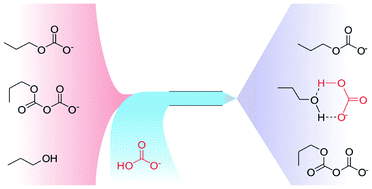Probing the formation of monoalkyl carbonates and pyrocarbonates in water with electrospray ionization mass spectrometry
Abstract
The anionic hemiesters of

* Corresponding authors
a
Department of Fundamental Chemistry, Institute of Chemistry, University of São Paulo, Av. Prof. Lineu Prestes, 748, São Paulo, SP, Brazil
E-mail:
claudemi@iq.usp.br
Tel: +55-11-30913828
b
Thomson Mass Spectrometry Laboratory, Institute of Chemistry, University of Campinas UNICAMP, 13083-970 Campinas, SP, Brazil
E-mail:
eberlin@iqm.unicamp.br
Fax: +55-19-3788-3073
The anionic hemiesters of

 Please wait while we load your content...
Something went wrong. Try again?
Please wait while we load your content...
Something went wrong. Try again?
D. T. R. Vidal, M. A. Santana, G. M. Hotta, M. N. Godoi, M. N. Eberlin and C. L. do Lago, RSC Adv., 2013, 3, 18886 DOI: 10.1039/C3RA42518E
To request permission to reproduce material from this article, please go to the Copyright Clearance Center request page.
If you are an author contributing to an RSC publication, you do not need to request permission provided correct acknowledgement is given.
If you are the author of this article, you do not need to request permission to reproduce figures and diagrams provided correct acknowledgement is given. If you want to reproduce the whole article in a third-party publication (excluding your thesis/dissertation for which permission is not required) please go to the Copyright Clearance Center request page.
Read more about how to correctly acknowledge RSC content.
 Fetching data from CrossRef.
Fetching data from CrossRef.
This may take some time to load.
Loading related content
